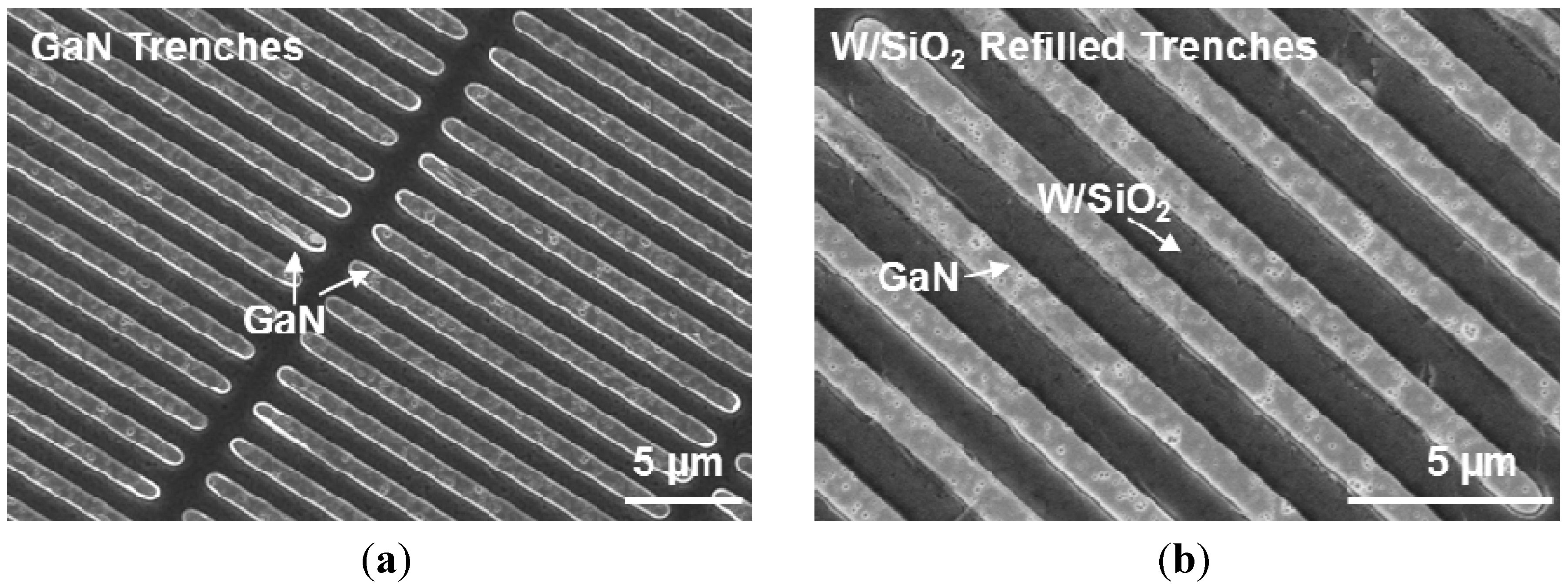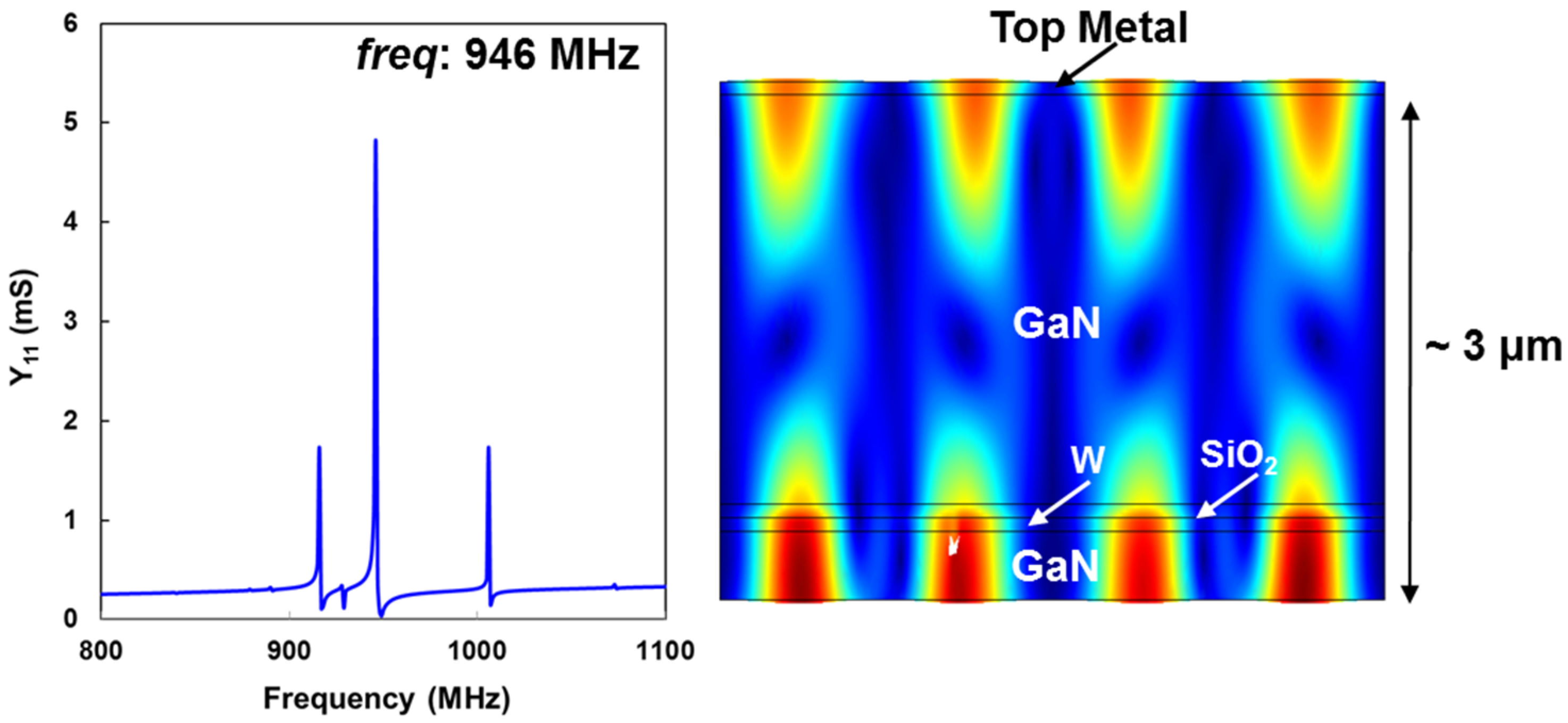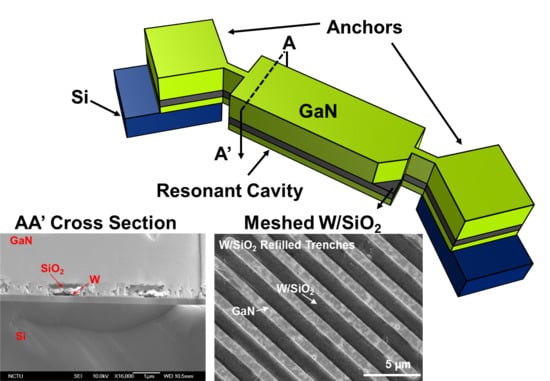GaN Micromechanical Resonators with Meshed Metal Bottom Electrode
Abstract
:1. Introduction

2. Resonator Architecture
2.1. Regrowth of GaN on Embedded Metal Grids


2.2. Experimental Results

3. Resonator Fabrication Overview
4. Placement of the W/SiO2 Meshed Bottom Electrode




5. Conclusions
Acknowledgments
Author Contributions
Conflicts of Interest
References
- Gokhale, V.J.; Roberts, J.; Rais-Zadeh, M. High performance bulk mode gallium nitride resonators and filters. In Proceedings of the International Conference on Solid-State Sensors, Actuators and Microsystems (Transducers), Beijing, China, 5–9 June 2011; pp. 926–929.
- Ansari, A.; Gokhale, V.; Roberts, J.; Rais-Zadeh, M. Monolithic integration of GaN-based micromechanical resonators and HEMTs for timing application. In Proceedings of the 2012 IEEE International Electron Device Meeting, San Francisco, CA, USA, 10–13 December 2012.
- Ansari, A.; Rais-Zadeh, M. An 8.7 GHz GaN micromechanical resonator with an integrated AlGaN/GaN HEMT. In Proceedings of the Solid-State Sensors, Actuators and Microsystems Workshop (Hilton Head Workshop), Hilton Head, CA, USA, 8–12 June 2014; pp. 295–296.
- Ansari, A.; Gokhale, V.J.; Thakar, V.A.; Roberts, J.; Rais-Zadeh, M. Gallium nitride-on-silicon micromechanical overtone resonators and filters. In Proceedings of the IEEE International Electron Device Meeting, Washington, DC, USA, 5–7 December 2011; pp. 485–488.
- Niebelschutz, F.; Cimalla, V.; Tonisch, K.; Haupt, C.; Brückner, K.; Stephan, R.; Hein, M.; Ambacher, O. AlGaN/GaN-based MEMS with two-dimensional electron gas for novel sensor applications. Phys. Status Solidi 2008, 5, 1914–1916. [Google Scholar] [CrossRef]
- Faucher, M.; Cordier, Y.; Werquin, M.; Buchaillot, L.; Gaquiere, C.; Theron, D. Electromechanical transconductance properties of a GaN MEMS resonator with fully integrated HEMT transducers. J. Microelectromech. Syst. 2012, 21, 370–378. [Google Scholar]
- Ansari, A.; Rais-Zadeh, M. HEMT-Based readout of a thickness-mode AlGaN/GaN resonator. In Proceedings of the IEEE Electron Device Meeting, Washington, DC, USA, 9–11 December 2013; pp. 1–4.
- Popa, L.C.; Weinstein, D. Switchable piezoelectric transduction in AlGaN/GaN MEMS resonators. In Proceedings of the 17th International Conference on Solid-State Sensors, Actuators and Microsystems (Transducers), Barcelona, Spanish, 16–20 June 2013; pp. 16–20.
- Ansari, A.; Rais-Zadeh, M. A thickness-mode AlGaN/GaN resonant body high electron mobility transistor. IEEE Trans. Electron Devices 2014, 61, 1006–1013. [Google Scholar] [CrossRef]
- Popa, L.C.; Weinstein, D. L-Band lamb mode resonators in gallium nitride MMIC technology. In Proceedings of the International Frequency Control Symposium, Taibei, Taiwan, 19–22 May 2014; pp. 559–562.
- Popa, L.C.; Weinstein, D. 2DEG electrodes for piezoelectric transduction of AlGaN/GaN MEMS resonators. In Proceedings of the European Frequency and Time Forum & International Frequency Control Symposium (EFTF/IFC), Prague, Czech Republic, 21–25 July 2013; pp. 922–925.
- Kyma Techologies. Available online: http://www.kymatech.com/ (accessed on 12 March 2015).
- Ansari, A.; Rais-Zadeh, M. A temperature-compensated gallium nitride micromechanical resonator. IEEE Electron Device Lett. 2014, 35, 1127–1129. [Google Scholar] [CrossRef]
- Thakar, V.A.; Wu, Z.; Peczalski, A.; Rais-Zadeh, M. Piezoelectrically transduced temperature-compensated flexural-mode silicon resonators. IEEE J. Microelectromech. Syst. 2013, 22, 819–823. [Google Scholar] [CrossRef]
- COMSOL. Available online: http://www.comsol.com/ (accessed on 14 March 2015).
© 2015 by the authors; licensee MDPI, Basel, Switzerland. This article is an open access article distributed under the terms and conditions of the Creative Commons Attribution license (http://creativecommons.org/licenses/by/4.0/).
Share and Cite
Ansari, A.; Liu, C.-Y.; Lin, C.-C.; Kuo, H.-C.; Ku, P.-C.; Rais-Zadeh, M. GaN Micromechanical Resonators with Meshed Metal Bottom Electrode. Materials 2015, 8, 1204-1212. https://doi.org/10.3390/ma8031204
Ansari A, Liu C-Y, Lin C-C, Kuo H-C, Ku P-C, Rais-Zadeh M. GaN Micromechanical Resonators with Meshed Metal Bottom Electrode. Materials. 2015; 8(3):1204-1212. https://doi.org/10.3390/ma8031204
Chicago/Turabian StyleAnsari, Azadeh, Che-Yu Liu, Chien-Chung Lin, Hao-Chung Kuo, Pei-Cheng Ku, and Mina Rais-Zadeh. 2015. "GaN Micromechanical Resonators with Meshed Metal Bottom Electrode" Materials 8, no. 3: 1204-1212. https://doi.org/10.3390/ma8031204
APA StyleAnsari, A., Liu, C.-Y., Lin, C.-C., Kuo, H.-C., Ku, P.-C., & Rais-Zadeh, M. (2015). GaN Micromechanical Resonators with Meshed Metal Bottom Electrode. Materials, 8(3), 1204-1212. https://doi.org/10.3390/ma8031204








